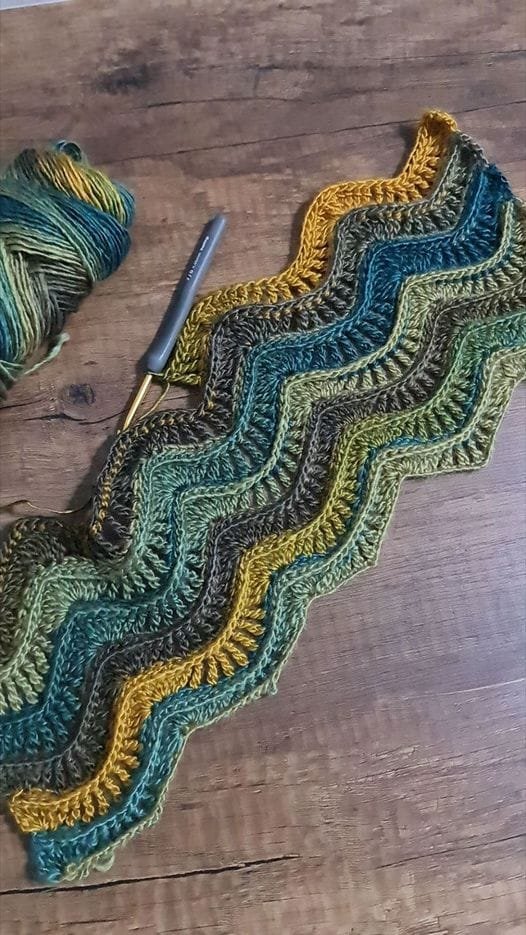The Feather & Fan Blanket is a classic and elegant knitting pattern loved by both beginners and experienced knitters. This timeless design creates a beautiful wave-like texture, adding a touch of sophistication to any home.
Whether you are making a baby blanket, a cozy throw for your living room, or a thoughtful handmade gift, the Feather & Fan Blanket is a versatile choice that never goes out of style.
This pattern is known for its simple yet effective lacework, making it perfect for knitters who want to practice basic increases and decreases while achieving a stunning result.

If you’re looking for a project that combines beauty, texture, and a touch of nostalgia, this guide will walk you through everything you need to know about creating your own Feather & Fan Blanket.
1. Understanding the Feather & Fan Pattern
The Feather & Fan Blanket is based on a traditional lace knitting technique that creates a wavy, scalloped effect. This is achieved through a simple four-row repeat, with one row of increases and decreases that form the signature ripple.
- The pattern consists of knit and purl stitches, along with yarn overs and decreases to create the lace effect.
- It is a fantastic introduction to lace knitting for beginners because of its repetitive and easy-to-memorize pattern.
- This stitch pattern can be adapted to different yarn weights and needle sizes, making it highly customizable.
- The undulating waves add an airy, lightweight texture, perfect for both warm and cool climates.
- The pattern works well with solid-colored yarns, but variegated or gradient yarns can enhance its visual appeal.
- The design has been around for centuries, making it a beloved choice for heirloom-quality projects.
2. Choosing the Right Materials
Selecting the best materials for your Feather & Fan Blanket is essential to achieving the perfect look and feel. Here are some important considerations:
- Yarn Type: Soft and breathable yarns such as cotton, wool, or bamboo blends work well for this pattern.
- Yarn Weight: The pattern can be adapted to various weights, including fingering, DK, worsted, or bulky yarn.
- Needle Size: Choose a needle size that complements your yarn weight while maintaining a slightly loose gauge for better drape.
- Color Selection: Solid colors highlight the lace pattern, while self-striping or gradient yarns add a dynamic effect.
- Blocking Tools: Blocking helps define the lacework, so consider using blocking mats and pins.
- Stitch Markers: These can help keep track of pattern repeats, ensuring accuracy as you knit.
3. Step-by-Step Knitting Instructions
Now that you have your materials, let’s go through the knitting steps to create your own Feather & Fan Blanket.
- Cast On: Begin by casting on a multiple of 18 stitches, plus an additional edge stitch on each side for stability.
- Row 1 (Right Side): Knit all stitches.
- Row 2 (Wrong Side): Purl all stitches.
- Row 3 (Right Side – Pattern Row): K2tog three times, (YO, K1) six times, K2tog three times, repeat to end.
- Row 4 (Wrong Side): Purl all stitches.
- Repeat Rows 1-4 until the blanket reaches your desired length.
- Bind Off: Bind off loosely to maintain the pattern’s elasticity.
- Blocking: Wet block or steam block the finished blanket to enhance the lace definition.
4. Tips for Perfecting Your Feather & Fan Blanket
Even though this pattern is simple, a few key tips can help improve your results and make the process smoother.
- Use stitch markers to separate pattern repeats and avoid mistakes.
- Count your stitches frequently to ensure that increases and decreases remain balanced.
- Choose a larger needle size if you prefer a more delicate, drapey look.
- Experiment with different yarn textures to achieve unique variations in appearance.
- Avoid over-tightening your tension on the yarn overs to keep the lace effect open and airy.
- Consider adding a decorative border like a garter stitch or scalloped edge for a polished finish.
Frequently Asked Questions (FAQ)
Q: Is the Feather & Fan Blanket suitable for beginners?
A: Yes! The pattern is easy to follow, with only four repeating rows, making it ideal for beginners learning lace knitting.
Q: Can I use different yarn weights for this pattern?
A: Absolutely! You can use anything from fingering to bulky weight yarn. Just adjust your needle size accordingly.
Q: How do I prevent my blanket from curling at the edges?
A: Adding a border, such as garter stitch or seed stitch, can help prevent curling.
Q: How long does it take to knit a Feather & Fan Blanket?
A: The time required depends on the size of the blanket and your knitting speed, but a small baby blanket can take a few weeks.
Q: What is the best way to block the finished blanket?
A: Wet blocking is the most effective method. Soak the blanket, lay it flat on blocking mats, and pin it into shape.
Join our VIP broadcast list and gain access to exclusive patterns, all for free. As a VIP member, you’ll receive the best patterns daily, delivered directly to your device. ✨📱 It’s a unique opportunity to stay up-to-date with the latest trends and designs, curated just for you. Don’t miss out on enhancing your projects and discovering new inspirations with the best patterns every day! 🎨🔝
Conclusion
The Feather & Fan Blanket is a delightful project that blends simplicity with elegance. Whether you’re making it for a loved one or adding it to your collection, this pattern offers versatility and timeless beauty. With the right yarn, needles, and techniques, you can create a stunning heirloom piece that will be cherished for years to come.
Have you tried knitting a Feather & Fan Blanket? We’d love to hear about your experience! Share your thoughts, tips, and suggestions in the comments below. Happy knitting!




